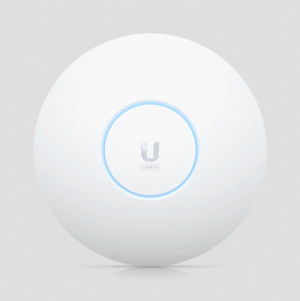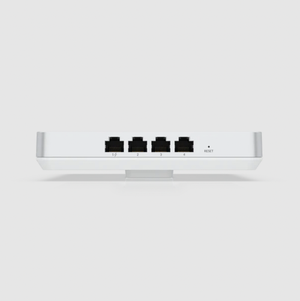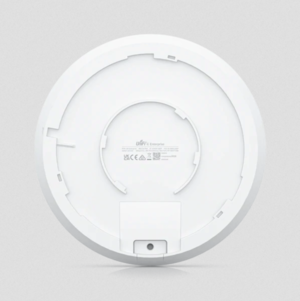U6-Enterprise Preview: UniFi's First Wi-Fi 6E AP
- Nanotech Solutions

- Sep 4, 2023
- 5 min read
Updated: Sep 26, 2023
UniFi U6-Enterprise Preview and Wi-Fi 6E Deep Dive
Wi-Fi 7 (802.11be) is under development, but Wi-Fi 6E is here. Adoption and supply chain issues have limited it’s impact, but the Wi-Fi Alliance estimates that 350 million Wi-Fi 6E devices will enter the market in 2022. On February 11th, 2022, Ubiquiti added their first Wi-Fi 6E access point to their early access store, the U6-Enterprise.
The Access Point WiFi 6 Enterprise (U6 Enterprise) is a next-generation, enterprise-grade access point designed to take advantage of WiFi 6E speeds. Ideal for demanding, high-density networks, the U6 Enterprise can support up to 600+ clients over its 2.4, 5, and 6 GHz channels. Each of the U6 Enterprise's three bands also utilizes OFDMA technology, which tactically distributes high volumes of data to ensure that your clients maintain a reliably fast, quality connection.
On June 17th, 2022, Ubiquiti added the U6-Enterprise-In-Wall, which is another tri-band Wi-Fi 6E model. The Enterprise In-Wall is much larger than the older AC-In-Wall and AC-In-Wall-HD, covering a full 2-gang (double) outlet rather than a 1-gang (single) outlet that the past models covered. The Enterprise In-Wall can still be mounted to a 1-gang outlet, with the included wall plate adapter. It just needs more space for it's hotter components, 2.5 Gbps uplink, and tri-band antenna and radio array.
Since Ubiquiti prohibits product reviews of Early Access equipment, we can’t cover the details of how the U6-Enterprise performs. If you're interested in a comparison of all other UniFi APs, see my UniFi Wi-Fi Access Point Buyers Guide and my U6-Pro and U6-Mesh Review and Speed Comparisons. In the mean time, it is also helpful to understand what Wi-Fi 6E is, and how 6 GHz differs from 2.4 GHz and 5 GHz. Strap in, relax your shoulders, and grab a beverage. This dive is going deep.
Table of Contents
U6-Enterprise and U6-Enterprise-In-Wall Specs ↩︎
Nerdy Details of the U6-Enterprise ↩︎
What is Wi-Fi 6E? ↩︎
5 GHz vs. 6 GHz Wi-Fi Speed and Coverage ↩︎
Nerdy Details of 6 GHz and Wi-Fi 6E ↩︎
6 GHz Power Limit Implications ↩︎
Understanding Wi-Fi Speeds ↩︎
The Case For 2.5 Gbps Uplinks ↩︎
Specifications
U6-ENTERPRISE SPECS
Powerful, ceiling-mounted WiFi 6E access point designed to provide seamless, multi-band coverage within high-density client environments.
Radios
Tri-band, 10.2 Gbps aggregate throughput rate
6 GHz
4x4 DL/UL MU-MIMO and OFDMA
Max Radio Rate: 4.8 Gbps
Max TX Power: 26 dBm (6 GHz limited by PSD, not EIRP)
Antenna Gain: 6 dBi
5 GHz
4x4 DL/UL MU-MIMO and OFDMA
Max Radio Rate: 4.8 Gbps
Max TX Power: 26 dBm
Antenna Gain: 5.3 dBi
2.4 GHz
2x2 UL MU-MIMO
Max Radio Rate: 570 Mbps
Max TX Power: 22 dBm
Antenna Gain: 3.2 dBi
Ports and Power
(1) 2.5GbE RJ45 Ethernet Input
Powered with 802.3at PoE+
PoE injector not included
Optimized for use with USW Enterprise switches, supporting 2.5GbE PoE switching
Supports up to 600+ clients
Included mounting plate, backing plate, and screw kit for quick and easy installation
$299 US MSRP
U6-ENTERPRISE-IN-WALL SPECS
Sleek, wall-mounted WiFi 6E access point with an integrated four-port switch designed for high-density office networks.
Radios
Tri-band, 10.2 Gbps aggregate throughput rate
6 GHz
4x4 DL/UL MU-MIMO and OFDMA
Max Radio Rate: 4.8 Gbps
Max TX Power: 26 dBm (6 GHz limited by PSD, not EIRP)
Antenna Gain: 5.8 dBi
5 GHz
4x4 DL/UL MU-MIMO and OFDMA
Max Radio Rate: 4.8 Gbps
Max TX Power: 26 dBm
Antenna Gain: 5.8 dBi
2.4 GHz
2x2 UL MU-MIMO
Max Radio Rate: 570 Mbps
Max TX Power: 22 dBm
Antenna Gain: 4 dBi
Ports and Power
(1) 2.5GbE RJ45 Ethernet Input
4-port Gigabit switch with (1) PoE passthrough output
Powered with 802.3at 30W PoE+, 802.3bt 60W PoE++, or 48V PoE injector input
PoE passthrough requires PoE++ in
PoE injector not included
Supports up to 600+ clients
Included aluminum mounting plate and screw kit for quick and easy installation over top of single or double duplex wall outlet.
$299 US MSRP
Nerdy Details of the U6-Enterprise
The specs of the U6-Enterprise and U6-Enterprise-In-Wall are straightforward, but 6 GHz Wi-Fi isn’t. Wi-Fi is a complicated technology that is often misunderstood. That’s especially true with newer standards and revisions such as Wi-Fi 6E and Wi-Fi 6 Release 2.
Thankfully, there are a lot of good white papers on Wi-Fi 6E, and the U6-Enterprise has been in the FCC database since July 2021. The public listing of the regulatory paperwork reveals a few other details.
The FCC model ID is SWX-U6EP
Ubiquiti’s original application was rejected, and this rejection letter from August 2021 is a fun read.
The rules governing 6 GHz certification for the FCC are described here.
The U6-Enterprise is a 61D class Low Power Indoor (LPI) Access Point.
The U6-Enterprise will support DFS operation in 5 GHz, and 4x4 MIMO with 160 MHz channels in 5 GHz and 6 GHz.
It’s the same size and shape as the U6-LR and AC-HD.
The U6-Enterprise doesn’t come with a power injector, and all the injectors Ubiquiti sells only support 100 Mbps or 1 Gbps connections. To power the U6-Enterprise and get a 2.5 Gbps Ethernet connection, you’ll need:
Switch Enterprise 8 PoE - $479
Switch Enterprise 24 PoE - $799
Switch Enterprise 48 PoE - $1,599
3rd Party switch capable of 2.5 Gbps and 802.3at PoE+
3rd party PoE injector such as TRENDnet’s TPE-215GI with a 2.5 Gbps switch.
Of course, you can plug it into a Gigabit PoE+ injector or Gigabit Ethernet PoE+ switch. But is that really living?
What is Wi-Fi 6E?
In April 2020 the United States FCC voted to allow the unlicensed use of the 6 GHz band. This added 1200 MHz of spectrum (5.925 to 7.125 GHz) for devices like Wi-Fi access points. Previously, devices operating in this band had to be licensed, which prevented use by the general public. Since then more than 70 countries have followed, with some opting for different rules. Some areas such as the European Union chose to only allow unlicensed operation in the U-NII-5 band, adding 500 MHz rather than the full 1200 MHz. Chuck Lukaszewski has a great overview of the current status of Wi-Fi 6E on the Wi-Fi Alliance Beacon blog.
For perspective, there is around 260 MHz of unrestricted spectrum available in the 2.4 GHz and 5 GHz bands. The exact channels available vary by region, and it’s easy to get bogged down in specifics. What matters is that this limited amount of contiguous spectrum makes it difficult to enable wider 80 MHz or 160 MHz channels. Wider channels offer higher throughput, but also present a lot of issues and design challenges such as channel re-use and interference when used in the crowded 2.4 GHz and 5 GHz bands.
The desire for wider channels and more continuous spectrum is why the addition of the 6 GHz spectrum is such an important change. The additional 1200 MHz of spectrum comes with more asterisks and details than I cover below. If you’re interested in more depth, search for Wi-Fi 6E white papers such as A Guide to Wi-Fi 6E from Litepoint (direct PDF link).
5 GHz vs. 6 GHz Wi-Fi Speed and Coverage
There’s nothing special about 6 GHz to reduce latency, or increase speeds. Wi-Fi 6E uses the same PHY standard, MIMO, and modulation rates from Wi-Fi 6. The only new thing is the 6 GHz spectrum, and the rules surrounding its use. An 80 MHz channel in 5 GHz is going to perform similar to an 80 MHz channel in 6 GHz, with a few caveats:
Higher frequencies attenuate faster, so 6 GHz signals by their nature offer slightly less range than 5 GHz. This varies by channel, but can be roughly estimated as a 10% reduction in range at a given power level. AP placement for good 5 GHz and 6 GHz coverage is nearly identical.
6 GHz offers more channels and should have less issues with interference. 6 GHz allows for up to seven 160 MHz channels or fourteen 80 MHz channels, depending on the rules in your area. This additional spectrum makes wide channels more usable in the real world, especially in networks with multiple APs.
Wi-Fi 6E APs are typically tri-band to maintain backwards compatibility. Only Wi-Fi 6E clients can use the 6 GHz radio, all other clients have to use 2.4 or 5 GHz.
In general, 6 GHz might be faster, if you’re near an AP using wide channels. 2.4 GHz and 5 GHz still have advantages, such as longer range, better wall penetration, and legacy compatibility.













コメント